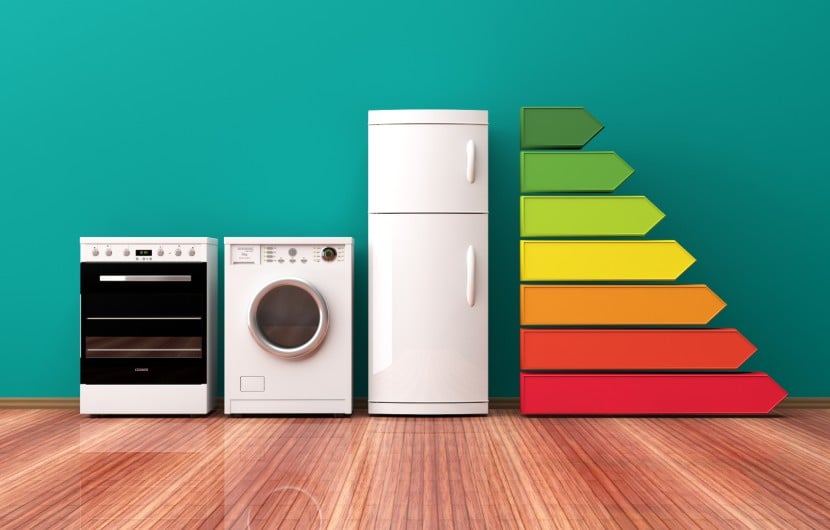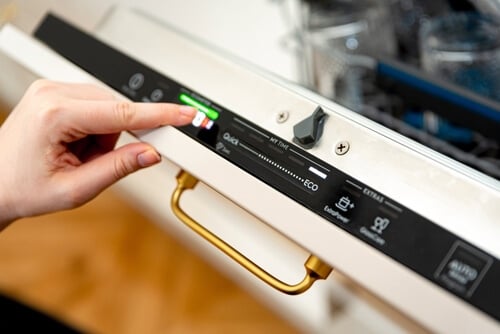The rising cost of fossil fuels has caused the price of energy to soar over the last year. Here’s what you could be paying to run your appliances and some ways you can save on your energy.

How much is the average electricity bill in the UK?
What you pay for energy depends on your usage and who you share your home with. It could also vary depending on where you are in the UK, and the type of appliances you have.
For example, some freezers are more energy efficient than others.
But on average, Ofgem estimates that an average British household of 2.4 people uses around 12,000kWh for gas and 2,900kWh for electricity per year 1.
That’s 1,000 kWh for gas and 241 kWh for electricity per month.
Ofgem has also estimated what a low, medium and high energy user might use per year in gas and electricity:
- Low - Gas: 8,000 kWh Electric: 1,800 kWh
- Medium - Gas: 12,000 Electric: 2,900
- High - Gas: 17,000 Electric: 4,300
This year, the government introduced the Energy Price Guarantee to protect customers from the rising wholesale price of energy. The scheme capped the cost of units of energy for standard variable rate tariff customers and reduced unit costs for customers on a fixed tariff.
| Fixed tariff | Standard variable rate | Standing charge | |
|---|---|---|---|
|
Electricity
|
Reduced by 17p/Kwh
|
34.0p/kWh (inc. VAT)
|
46p per day
|
|
Gas
|
Reduced by 4.2p/Kwh
|
10.3p/kWh (inc. VAT)
|
28p per day
|
Now, the average household’s energy bill should be £2,500. Households could have been paying roughly £1,000 more for energy if the Price Guarantee hadn’t been announced.
Remember, this isn’t a cap on your total bill. You could be charged more if your energy usage is high, for example.
Prior to the announcement, the price of a standard variable rate SVR tariff was determined by the average energy price cap unit rates set out by Ofgem. But because the price of wholesale energy was increasing rapidly, the government had to step in.
To calculate the average bill for a low, medium and high energy user, we’ve based our prices on the SVR tariff cost. This is usually the tariff that you’re put onto when your fixed term deal ends. Here’s what the average energy cost for different energy users could look like per month and year:
| Usage type | Typical usage in kWh* | Average annual cost** | Average annual cost for gas and electricity | Monthly average cost for gas and electricity |
|---|---|---|---|---|
|
Low
|
Gas:
8,000
Electric:
1,800
|
Gas:
£902.20
Electric:
£779.90
|
£1,682.10
|
£140.18
|
|
Medium
|
Gas:
12,000
Electric:
2,900
|
Gas:
£1,302.20
Electric:
£1088.20
|
£2,390.40
|
£199.20
|
|
High
|
Gas:
17,000
Electric:
4,300
|
Gas:
£1802.20
Electric:
£1,629.90
|
£3432.10
|
£286
|
*Based on Ofgem’s typical energy usage table for low, medium and high usage households.
**Based on Energy price Guarantee unit rates from 1 October 2022 to 1 April 2023:
- Gas: £0.10 per kWh plus daily standing charge: £0.28
- Electric: £0.34 per kWh plus daily standing charge: £0.46
This is an estimate. Figures vary depending on usage, supplier and location in the UK.
Energy appliance usage specifics:
How much energy does it take to boil a kettle?
Based on using a kettle for 15 minutes a day - this might be higher if you’re a caffeine fiend - a kettle could use around 24 kWh per month.
On a standard variable rate tariff that works out at £8.16 per month.
One way to reduce this cost would be to cut down on your tea and coffee intake - which is easier said than done. Or only boil as much water as you need.
By only boiling as much water as you need, the Energy Savings Trust estimates you could save around £43 per year.
You can buy ‘one cup’ kettles that let you brew a single cup, helping you save even more.
How much energy does it take to run a tumble dryer?
A tumble dryer used by a family of 4 every week could use a total of 48 kWh per month. On a standard variable rate tariff, this could cost around £16.32 per month.
If you can, try air drying your clothes. Or dry them outside if the weather is ok. You could save around £70 a year if you stop using your tumble dryer altogether.
How much electricity does a washing machine use?
A weekly wash for a family of 4 could use around 36 kWh of electricity, working out at £12.24.
It’s hard to reduce your weekly washes, particularly if you have a family. But if you can, try cutting down on 1 wash per week and reducing your washing temperature from 40°C to 30°C.
You might save around £34 per year by doing this.
What do energy ratings mean and why are they important?
One way to potentially save energy and your bank balance from the outset is to buy an energy-efficient appliance.
When you buy a new appliance, it normally has a label telling you the energy rating. The energy ratings changed in 2021. Instead of using A+++ to E, the new scale runs from A to G.
The new scale gives a more accurate reading of the energy efficiency rating of appliances.
At the moment, the new energy efficiency scale applies to refrigerators, washing machines, washer-dryers, TVs, displays and dishwashers. For other products like ovens and tumble dryers, the new label should be introduced when new or revised UK regulations come into force.
But what do the energy efficiency ratings actually mean? Well it turns out that for your wallet, it means quite a lot.
Let’s look at fridge-freezers. Most of us have one and it’s on 24 hours a day. We’ll use the new ratings for this.
A fridge-freezer with an energy rating of D might use 408 kWh per year. This could cost you £138.72 to run if you’re on a standard variable rate tariff, subject to Energy Price Guarantee.
If you went for the most efficient fridge-freezer with an energy rating of A, the usage could drop significantly to 206 kWh per year.
This could cost you around £70 to run on a supplier’s SVR tariff.
So you can see how investing in an energy efficient appliance could save you nearly £70 per year on your energy use– and that’s just on a single appliance!
| ITEM | KWH PER MONTH | COST PER MONTH (£) STANDARD VARIABLE TARIFF* |
|---|---|---|
|
Air Con (8 hours per day)
|
492
|
£167,28
|
|
Electric heater (2 hours per day)
|
60
|
£20.40 |
|
Washing Machine (weekly washing for family of 4)
|
36
|
£12.24 |
|
Kettle (15 mins per day)
|
24
|
£8.16 |
|
Tumble Drier (weekly drying for family of 4)
|
48
|
£16.32 |
|
Fridge Freezer (A rating running 24/7)
|
17.2
|
£5.84 |
|
Fridge Freezer (D rating running 24/7)
|
34
|
£11.56 |
|
Games console - Xbox One X (4 hours per day)
|
21.6
|
£7.34 |
|
43” LED SMART TV (5 hours per day)
|
10.7
|
£3.63 |
|
Single incandescent light bulb [60 watts] (4 hours in the evening)
|
7.2
|
£2.45 |
|
Single LED bulb [15 watts] (4 hours in the evening)
|
1.8
|
61p |
|
Laptop (5 hours per day)
|
4.2
|
£1.43 |
|
Microwave (10 minutes per day)
|
4
|
£1.36 |
|
Vacuum Cleaner (2 hours a week)
|
4
|
£1.36
|
|
Hair dryer (5 minutes per day, 4 times a week)
|
3.33
|
£1.13 |
|
Lawn Mower (once a week)
|
3
|
£1.02 |
|
Hair Straighteners (5 minutes per day, 4 times a week)
|
2.46
|
83p |
Prices don’t include standing daily charge/membership fee, which varies between suppliers.
*Electricity price correct for the period 1 October 2022 to 1 April 2023 dictated by the Energy Price Guarantee. Electricity charged at 34p per kWh. Prices may differ due to rounding.
How to lower your appliance energy cost
As you can see, the biggest costs are typically on managing the temperature of your home. If you rely on air conditioning during the summer, you can clearly see the massive amount of energy used by doing so – equally, electric heaters are also pretty pricey.
When you add this to the cost of running your kettle, laptops, TVs, washing machines and hair straighteners, it can all contribute to a pretty big sum!
It might sound obvious, but you could easily save energy by:
- Keeping the doors shut and using draught excluders in the winter
- Opening a window if it’s summer and the weather is hot
- Checking for draughts from your window
Our home heating hacks can give you some simple, cost-effective ways to keep your home toasty too.
For more ideas of how to pay less on your gas and electricity bills, read our energy efficiency guide. And bear in mind that if you work from home, the extra hours spent in the house, which would normally be spent in the office, also push up your annual energy bills. So if you’re allowed back into your office, potentially working there for a few days a week could mean a saving.
If you run your business from home, and more than 50% of the energy you use is for business purposes, it’s worth considering a business energy account.
Can I switch energy providers?
Because of the volatile situation with energy, many suppliers have gone bust over the last year. This has meant that the options for energy switching are limited.
The Energy Price Guarantee has also limited the options for switching suppliers until April 2023.
Our switch ready programme can get you ready for when the energy market does return. You’ll have access to the latest deals, which are tailored to you. It only takes a minute to sign up:
- Log in to your Confused.com account and confirm your energy details
- We'll send personalised deals straight to your inbox
- When you're happy with your deal, we'll complete the switch for you
Get personalised electricity deals straight to your inbox
1 Figures correct for Ofgem’s average energy usage in 2020. New energy usage calculations have been delayed due to the pandemic. New figures should be released in 2023. You can find more details on this announcement at Ofgem.







